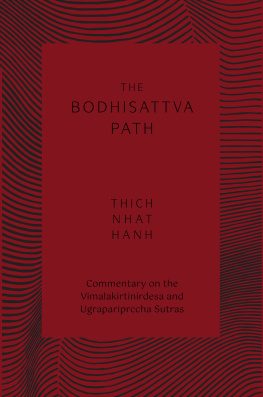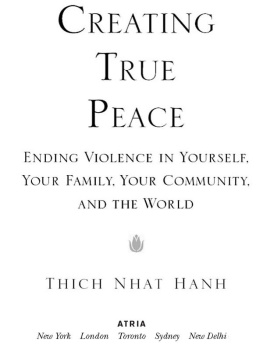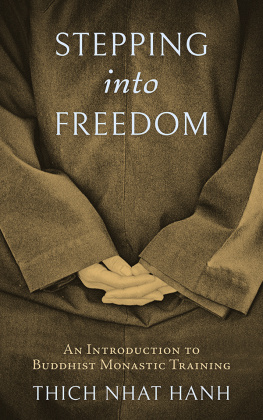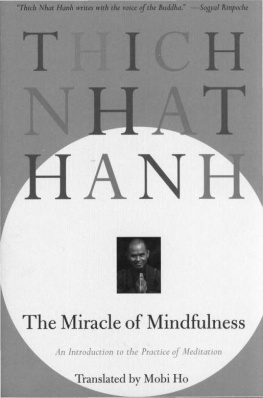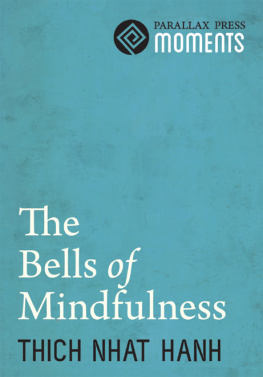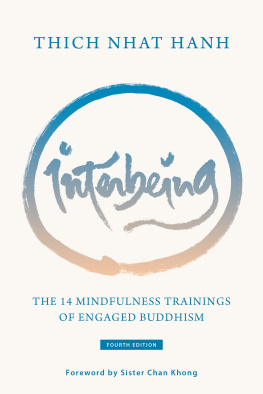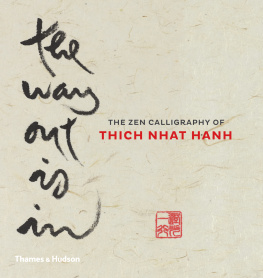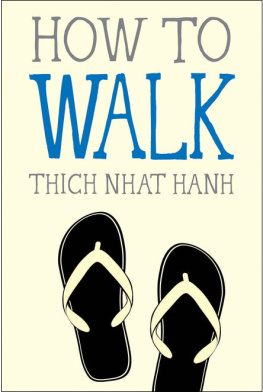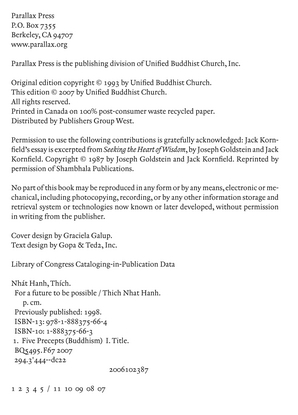This optimized ReadHowYouWant edition contains the complete, unabridged text of the original publisher's edition. Other aspects of the book may vary from the original edition.
Published in 2008 in the US and world markets by ReadHowYouWant.
The text in this edition has been formatted and typeset to make reading easier and more enjoyable for ALL kinds of readers. In addition the text has been formatted to the specifications indicated on the title page. The formatting of this edition is the copyright of Objective Systems Pty Ltd.
ReadHowYouWant partners with publishers to provide books for ALL Kinds of Readers. For more information about Becoming A RHYW Registered Reader and to find more titles in your preferred format, visit:
www.readhowyouwant.com
The Road Is Your Footsteps
JOAN HALIFAX
Wanderer, the road is your
footsteps, nothing else;
wanderer, there is no path,
you lay down a path in walking.
In walking, you lay down a path
and when turning around
you see the road youll
never step on again.
Wanderer, path there is none,
only tracks on the ocean foam.
WHENEVER I think about keeping the precepts in the practice of Buddhism, what Thich Nhat Hanh calls the Five Mindfulness Trainings, I think about two qualities: discernment and kindness. The Buddhist vows of good and right conduct, created in the time of the historical Buddha, are tied to the history and culture they come from. When the precepts are brought up to date and made culturally relevant, as in the case of Thich Nhat Hanhs retranslation and commentary in this book, our Buddhist vows are basically good medicine for our wayward minds and forgetful hearts. They remind us to see and point us toward kindness. Although our Original Nature might well be without blemish, most of us seem to have no small accumulation of dust on the mirror of our minds. Practice is about housecleaning. Precepts are a reminder that the house needs to be cleaned, and we best not forget that we forget to take care of ourselves and others. Heres how, say the precepts.
Practice is also about crafting the art of living beautifully, honestly, and with strength and dignity. Precepts are a refinement of this craft; they are a mindfulness tool and a tool of compassion that can open body, speech, and mind to original wholesomeness. Precepts are also about deepening the experience of community. Thy, as Thich Nhat Hanh is known to his friends and students, has said often that the precepts are our protectors: they protect us and they protect other beings as well. If we are to live in peace with each other, with the four worlds (mineral, plant, animal, and human) of Grandmother Earth, we need to dedicate ourselves to the path of nonviolence toward all. We see ourselves in each thing, in each being. We know that harming others through body, speech, or mind is harming a part of ourselves. We see that our so-called individual identity is tied to all other identities, and so we are not a separate or local self, but in a continuum with all else. Thus the precepts can bring us to this sense of deep responsibility toward the greater world and also responsibility for ourselves as well. They are, in essence, a way for us to take care of our global and very local community.
Yet the precepts also have their shadow. Like any guidelines, taken too rigidly, they can breed piety, self-righteousness, humorlessness, and even vengeance justified as helpful criticism. I have seen the precepts used as a weapon against others instead of as a tool of understanding. The humiliation and punishment of those who break the precepts seems to me to be counter to a Buddhist view of seeing ourselves as not separate from others and as empty of any identity. There are saner means for creating understanding in those who are deluded or in the thrall of aggression or passion. The way to understanding is through understanding, to paraphrase Thich Nhat Hanh. How can we help a heart to stop defending itself? How can our Original Innocence be retrieved? Certainly not through the coercion of punishment and public humiliation. This has been a big and sticky question in the West. I believe we have not yet seen our way through to a solution of compassion for all. Suffering has many faces. Victim and tyrant both suffer. Alienation takes many forms, including greed, jealousy, sexual obsession, righteousness, anger, hatred, hypocrisy, and other forms of acute confusion. Sufferings face is abuser and abused.
It is also too often true that people hide behind the precepts and practice in secret the opposite of what they preach. Yet the fact is that we break precepts all the time. If we are able to see this, then there is some small possibility that we may cultivate compassion not only for our very human selves but for others as well. The Japanese have an expression that seems to capture the sense of pathos that is at the heart of our all too human dilemma: mono no aware, the slender sadness. Simply by living we take life. Leather shoes and belts, breathing in and out, a cup of water, a flushing toilet, a stroll in the forest, raising mustard greens, flying here and there, the daily newspaper: in each, a thousand things are dying and being born. Our thoughts can never be as pure as white snow in a silver bowl. Our speech is only so skillful. Treating our bodies and the bodies of others as precious stuff is not so easy, driven as we are by duty or desire, fear or confusion. We are called to be honest about the struggle most of us face daily in living a wholesome life. Our world is not in a very healthy state. Between the degradation of our environment, the loss of values and meaning on a global and local level and the plain stuff of human suffering, the odds are pretty much against one realizing much long-lasting joy or equanimity. And this is why we practice: enlightenment is an accident; practice makes one accident-prone.
I believe that it is through our failures that the muscles of truth, compassion, and courage strengthen. Where we have been weak is where we find strategies for the development of our strengths. And often it takes a thorn to remove a thorn. Sometimes an act of so-called non-virtue is a helpful and skillful means. Striving for an unrealistic and exaggerated perfection is a madness that produces inauthenticity; in effect it can forge a monster of pretentiousness. Fall down into the darkness. Where are the knees of humility touching? Practice standing up. The spines of ten thousand things rise up with you. We are not alone in this wonderful struggle for truth. Thy once wrote that it is through our lives that we experiment with truth. The precepts are not truth. They usually point to the kindest alternative. But when a monk or nun in Vietnam offers the living body to the fire, where stands the truth of non-harming?
Once, in the highlands of Nepal at Thupten Chling Monastery near Junbese in the Solu Valley, hundreds of monks and nuns sat patiently in the gompa courtyard as the doctor with us gave them medical attention. Many were suffering from tuberculosis and cancer. All were smiling; self-pity was not present. We Westerners could hardly bear the sight of so much pain experienced with such great equanimity. When standing in their midst, I remembered the image of the first Vietnamese monk who immolated himself. His body in flames, he sat still in his own inferno, a lotus in a sea of fire. Was it the precepts that brought him to this radical act of self-annihilation? In part, I believe that the precepts protected him as he gave his flesh to the flames. In taking his own life, he knew he might save many. And it takes keen and radical discernment as well as great love to make such an offering to others. Breaking the precepts, he kept the precepts.


